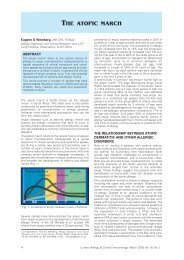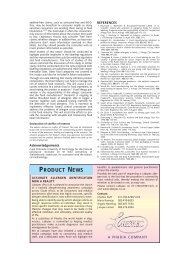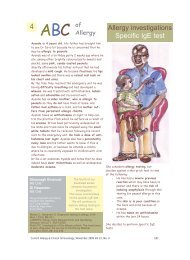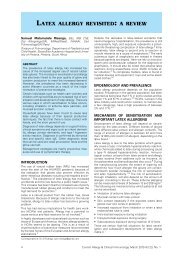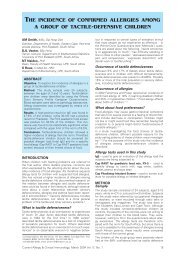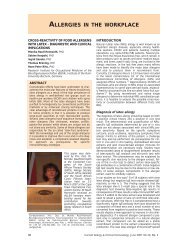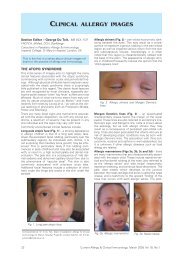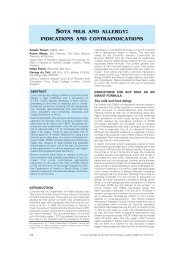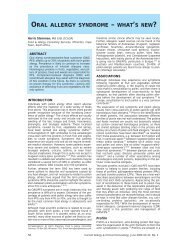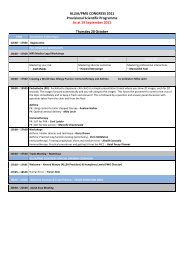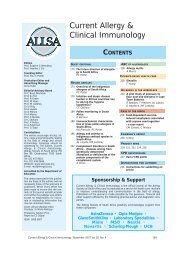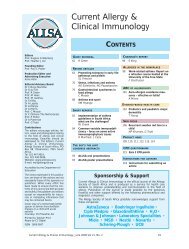Current Allergy and Clinical Immunology - March 2008
Current Allergy and Clinical Immunology - March 2008
Current Allergy and Clinical Immunology - March 2008
Create successful ePaper yourself
Turn your PDF publications into a flip-book with our unique Google optimized e-Paper software.
PRODUCT NEWSNASONEX IS NOW INDICATED FROMTHE AGE OF 2 YEARS!Nasonex Aqueous Nasal Spray is indicated for use inadults, adolescents <strong>and</strong> children between the agesof 2 <strong>and</strong> 11 years to treat the symptoms of seasonalallergic or perennial allergic rhinitis.In patients who have a history of moderate to severesymptoms of seasonal allergic rhinitis, prophylactictreatment with Nasonex Aqueous Nasal Spray is recommendedprior to the anticipated start of the pollenseason.Dosage <strong>and</strong> directions for useAdults <strong>and</strong> adolescents: The usual recommendeddose for prophylaxis <strong>and</strong> treatment is two sprays (50µg/spray) into each nostril once daily (total dose200 µg). Once symptoms are controlled, dose reductionto one spray into each nostril (total dose 100 µg)may be effective in some patients for maintenance.Children between the ages of 2 <strong>and</strong> 11 years: Theusual recommended dose is one spray (50 µg/spray)in each nostril once daily (total dose 100 µg).For more information contactGary Vine,Schering-Plough (Pty) Ltd,011-922-3300.PIMECROLIMUS CREAM 1% IN ATOPICDERMATITIS: A 6-MONTH, OPEN-LABELTRIAL IN PAEDIATRIC PATIENTSPimecrolimus, a new, non-steroid, inflammatorycytokineinhibitor, has been shown to prevent progressionto flare in atopic dermatitis (AD) <strong>and</strong> toimprove long-term disease control when applied as a1% cream. In this 6-month, open-label, multinationalstudy, 177 infants aged 3-23 months <strong>and</strong> 489 childrenaged 2-17 years, with mild to severe AD, were included.The study was designed to evaluate the efficacy<strong>and</strong> safety of pimecrolimus cream 1% used as a firstlinetreatment. Treatment consisted of an initial bidregimen, for as long as signs <strong>and</strong> symptoms of diseasepersisted; this was followed by treatment asrequired at the first signs <strong>and</strong> symptoms of AD.Emollients were allowed as per the physician's normalpractice, <strong>and</strong> topical corticosteroids could be used totreat severe flares at the discretion of the physician.Efficacy was assessed by evaluations of pruritus, <strong>and</strong>total-body <strong>and</strong> facial Investigators' GlobalAssessment (IGA). Results from the first return visit(day 7) showed an improvement from baseline of 1in total-body <strong>and</strong> facial IGA for infants (59.1% <strong>and</strong>72.8% of patients, respectively) <strong>and</strong> children (59.3%<strong>and</strong> 62.2%, respectively). Pruritus was absent or mildin 67.8% <strong>and</strong> 65.4% of infants <strong>and</strong> children, respectively.This level of improvement in the patient populationwas maintained throughout the 6-month study.Adverse events occurred in 75.7% of infants <strong>and</strong>71.1% of children. Most adverse events were commonchildhood illnesses that would be expected inthis population (e.g. nasopharyngitis (infants 22.0%,children 12.8%), upper respiratory tract infection(infants 18.6%, children 11.9%) <strong>and</strong> cough (infants8.5%, children 10.1%)). Concerning pimecrolimus'slocal tolerability, application-site burning occurred in2.3% of infants <strong>and</strong> 7.0% of children, <strong>and</strong> local pruritusoccurred in 0.6% infants <strong>and</strong> 1.0% children.Application-site reactions were most frequentlyreported during the first 6 weeks of treatment <strong>and</strong>were mild to moderate in intensity. In conclusion,pimecrolimus cream 1% was effective in the treatmentof the early signs <strong>and</strong> symptoms of AD (including pruritus)in infants <strong>and</strong> children, <strong>and</strong> demonstrated agood safety profile.Reference available on request. Contact Thoko Nzama, 011-929-911156 <strong>Current</strong> <strong>Allergy</strong> & <strong>Clinical</strong> <strong>Immunology</strong>, <strong>March</strong> <strong>2008</strong> Vol 21, No. 1



